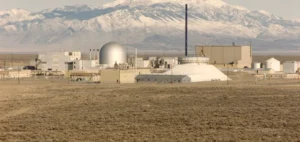MOX, a nuclear fuel containing plutonium, arrived in the night of Tuesday to Wednesday on the port of Cherbourg (Manche) while waiting to be transported to its final destination Japan, a photographer of the AFP noted.
These highly radioactive substances were transported overnight in two trucks in secure packages from the Orano plant in La Hague, 20 km from Cherbourg, to the port, the company said. The convoy arrived around 3:45 a.m. at the port, flanked by numerous law enforcement vehicles, according to the photographer.
Shortly after 06:00, a first package of fuel was loaded aboard the Pacific Egret, a ship belonging to the British shipping company PNTL (Pacific Nuclear Transport Limited), which has “long experience” of this type of transport, according to Orano.
During the previous transport of MOX from Cherbourg to Japan, in September 2021, the ship left the port in the afternoon following the morning of loading the fuel.
“Armed British police forces” are “on board” during the shipping, which is expected to last just over two months, according to the nuclear group.
In a press release, environmental associations such as France Nature Environnement (FNE) said they were “opposed to the return of plutonium” which, according to them, could “contribute to the proliferation of nuclear weapons”.
MOX is composed of 8% plutonium oxide and 92% uranium oxide, according to Orano.
“In a world today extremely destabilized, in crisis with Russia as well as with China and Taiwan, transporting such dangerous materials from a nuclear proliferation point of view is completely irresponsible,” said Yannick Rousselet of Greenpeace France.
According to Orano, “the plutonium contained in MOX is not the same as that used by the military”.
For Greenpeace, “it is perfectly possible” to make a bomb with this plutonium. Plutonium is “the world’s greatest radiotoxicant,” according to the organization.
At Orano’s request, the courts have forbidden anyone to approach the convoy under penalty of financial sanctions.
According to Orano, MOX is a nuclear fuel that allows the recycling of spent fuel. It is made from materials from the spent fuel in the power plants to produce electricity.
However, it represents only 10% of the fuel used in French power plants, according to the company.
The MOX fuel being loaded in Cherbourg was manufactured from irradiated fuel in Japan.






















